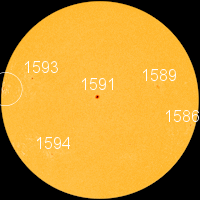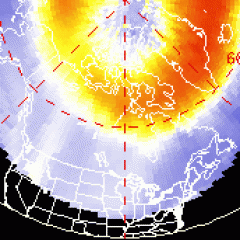~Space Weather Update~ Solar Wind Speed 588 [1]
ORIONID METEOR SHOWER: Next weekend, Earth will pass through a stream of debris from Halley's Comet, source of the annual Orionid meteor shower. Forecasters expect ~25 meteors per hour when the shower peaks on Oct. 21st. [video [2]] [full story [3]] [NASA Chat [4]]
BAY AREA FIREBALL: Last night, Oct. 17th, many people near San Francisco saw a slow-moving fireball exploding in the sky around 07:45 pm PDT. Witnesses [5] report bright flashes of light and sonic booms that shook houses. Using a wide-field camera, Wes Jones caught the meteor disappearing behind the trees in the city of Belmont:
"We don't know yet if the end point [of the meteor's flight] was over land or water," says meteor expert Peter Jenniskens of the NASA Ames Research Center. Jenniskens operates a network of Cameras for All-sky Meteor Surveillance (CAMS [6]) near the Bay Area. "Data from the CAMS system should give us an answer [about landfall]. We're analyzing the data now." Stay tuned.
Note: Although Earth is nearing a stream of debris from Halley's Comet, source of the Orionid meteor shower [3], this fireball was probably not an Orionid. The timing and direction of the meteor do not seem to match the Orionids.

![]()
Solar wind
speed: 588.2 km/sec
density: 0.1 protons/cm3
explanation [7] | more data [8]
Updated: Today at 1447 UT
![]()
X-ray Solar Flares
6-hr max: B6 0908 UT Oct18
24-hr: B6 0908 UT Oct18
explanation [9] | more data [10]
Updated: Today at: 1359 UT
![]()
![]()
![]()
Daily Sun: 18 Oct 12
![]()
![]()
A potentially significant sunspot is emerging at the circled location. Credit: SDO/HMI
![]()
![]()
![]()
Sunspot number: 100
What is the sunspot number? [12]
Updated 18 Oct 2012
Spotless Days
Current Stretch: 0 days
2012 total: 0 days (0%)
2011 total: 2 days (<1%)
2010 total: 51 days (14%)
2009 total: 260 days (71%)
Since 2004: 821 days
Typical Solar Min: 486 days
Update 18 Oct 2012
The Radio Sun
10.7 cm flux: 135 sfu
explanation [13] | more data [14]
Updated 18 Oct 2012
![]()
![]()
![]()
Current Auroral Oval:
![]()
Switch to: Europe, USA, New Zealand, Antarctica
Credit: NOAA/POES
![]()
![]()
![]()
Planetary K-index
Now: Kp= 1 quiet
24-hr max: Kp= 2 quiet
explanation [16] | more data [17]
![]()
Interplanetary Mag. Field
Btotal: 4.1 nT
Bz: 1 nT south
explanation [18] | more data [19]
Updated: Today at 1446 UT
![]()
![]()
![]()
Coronal Holes: 18 Oct 12
![]()
![]()
There are no large coronal holes on the Earthside of the sun. Credit: SDO/AIA.
Category:
- Ground Crew Updates [21]



